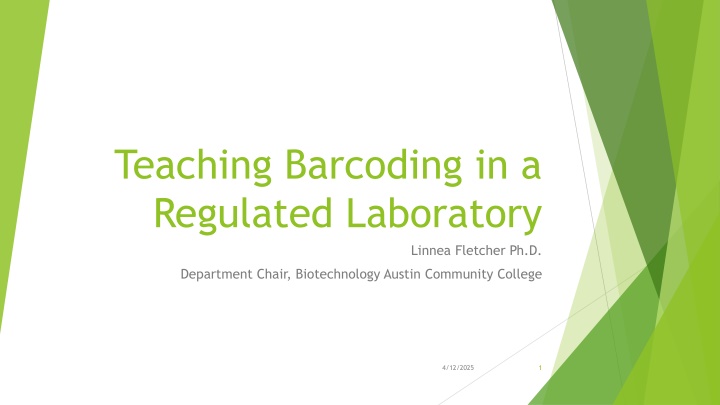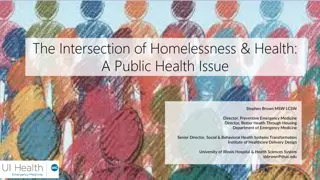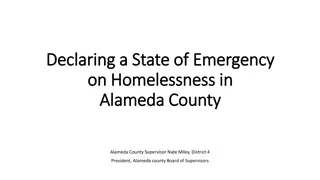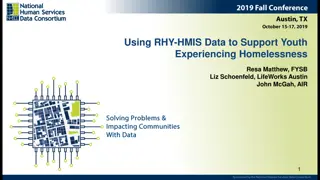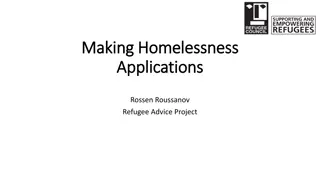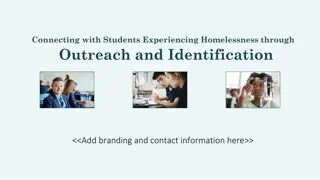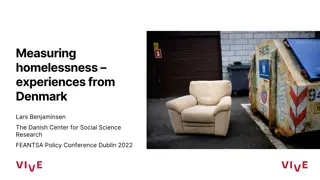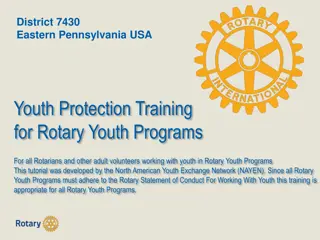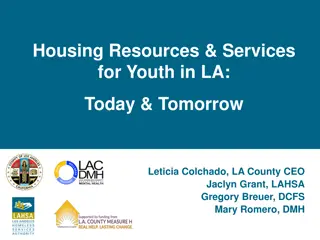Youth Homelessness Prevention Resources
Addressing Youth Homelessness through Safety Nets and Support Services for Vulnerable Populations. Explore community agreements, continuum of services, safety nets, barriers, and disproportionality in systems affecting homeless youth.
Download Presentation

Please find below an Image/Link to download the presentation.
The content on the website is provided AS IS for your information and personal use only. It may not be sold, licensed, or shared on other websites without obtaining consent from the author.If you encounter any issues during the download, it is possible that the publisher has removed the file from their server.
You are allowed to download the files provided on this website for personal or commercial use, subject to the condition that they are used lawfully. All files are the property of their respective owners.
The content on the website is provided AS IS for your information and personal use only. It may not be sold, licensed, or shared on other websites without obtaining consent from the author.
E N D
Presentation Transcript
Teaching Barcoding in a Regulated Laboratory Linnea Fletcher Ph.D. Department Chair, Biotechnology Austin Community College 4/12/2025 1
Agenda Discussion on how to convert classroom and other parameters into a regulated environment (and what is NOT converted) Discussion on how to convert curriculum what additional information is needed Presentation and discussion of two student presentations (they are in different stages of development) Share Student Employability Form 4/12/2025 2
Outcomes Learn how ACC Biotech Program prepares students for working in a regulated laboratory environment (E.g. cGDP, cGMP) Learn how the program transforms academic curricular materials into technician workforce appropriate materials (biotechnicians design and make the kits! So the appropriate info needs to be shared with students) Learn how the program works to make students independent learners 4/12/2025 3
Materials Provided Laboratory Notebook for Introductory Biotechnology Course Documentation Form Notebook for the Program Student Employability Evaluation SOP book for the program Items not provided but discussed: The hybrid Blackboard course materials including learning outcomes, presentations, kit information, and DNALC videos and information Biotechnology Methods course laboratory book Two student presentations on barcoding and phylogenetics 4/12/2025 4
Background on the ACC Biotech Program Established over 20 years ago based on best practices gathered through the Bio- Link Community (all of the biotech programs in the nation) Awards an AAS to 2-year students, an entry-level certificate (entry level biomanufacturing), and a Advanced Technical Certificate to 4 year students Articulates with dual credit high school biotechnology programs Year ONE involves mastering basic techniques, basic regulatory information, and entry level biomanufacturing Year TWO involves courses in cell culture, biomanufacturing, instrumentation, molecular techniques, bioinformatics All certificates and awards end with an internship 90 to 100% placement in industry AND we share lab space with the MLT Program (a real plus!) 4/12/2025 5
Important Guidelines for the Program To some degree, every course simulates a biotech industry lab and adheres to Texas Biotechnology Skill Standards At the end of the program for a student, it is not what the instructor knows what a student can do- it is what the student knows he/she can do, to what degree he/she can do it, how to gain new information, have the resiliency to accomplish difficult tasks Understand the requirements for the job AND most importantly, that he/she wants to work in the industry! 4/12/2025 6
Texas Biotechnology Skill Standards (www.tssb.org) 4/12/2025 7
Convert Course to a Regulated Environment (cGMP) and Adhere to Skill Standards https://www.ma nufacturingchemi st.com/news/art icle_page/GxP_T he_5_Ps_of_Goo d_Practice/1534 85 4/12/2025 8
Introduction to Biotechnology People Rubrics, Employability Evaluation, Lab Tests, Presentations, Tests, Students (Colleagues) Sign Up for LinkedIn, Program Listserv SOPs, Prelab, Calibrate Equipment, Operate Equipment, Master Writing SOPs, Prepare Lab Manual, Deviation on Procedures Raw Material Control (when possible), Proper Labeling, Storage of Materials and Products, Quality Testing and Documentation Safety and Security Guidelines Followed and Documented, IQ,OQ,PQ, Log books, Deviation Reporting on Equipment, Clean Up What is Done in the Course is Done in the Program, Lab Manuals, Course Materials, Updated and shared with faculty, Data from Experiments Collected and Reviewed with Previous Course Data Procedures Products Premises and equipment Processes (Department, Course) 4/12/2025 9
What In the Course --- Is Not Like In A Company Students can fail at what they are doing without a grading consequence as long as they learn from that failure It takes practice and repetition to be successful in a regulated laboratory environment- at documentation, at data analysis, setting up experiments, remembering all of the controls, at multitasking- at figuring out the best way for an individual to learn and accomplish tasks At the beginning of the semester, when we review the syllabus, and if problems occur during the semester, students have a say concerning when items are due, grading rubrics, and point values assigned to the rubrics Learning is scaffolded but mastery is mandatory Students can redo initial items graded in the course such as the first lab report (maybe even the second) Students can virtually practice their presentations with the class Students realize it is not the grade but the mastery of all techniques that is important 4/12/2025 10
Transforming the Curriculum: Workflow for Barcoding http://dnabarcoding101.org/ Pick the specimen Photo and GPS location Isolate the DNA (dissect the kit) Understand how DNA is isolated and the quality of the DNA is determined (review how to pick and order DNA isolation kit, how to troubleshoot kit and contact company if there are problems, how to store it, quantify it, do quality analysis of the DNA, and store DNA Amplify the target site (PCR) (large subunit Rubisco) Understand the basic concepts behind primer design, PCR reaction design, preparation of Master Mix, and determining quality of the product (dissect how all reagents and the PCR reaction was designed) Prepare sample for sequencing Understand the basic concepts behind Sanger and NGS and how they are different, what Gene Whiz does when they get the samples (Once again, dissect the procedures for sample prep, and sequencing) Analyze the quality of the sequence using the Blue line (dissect how the program was designed to some degree) Prepare the sequence for annotation (dissect) Annotate the sequence using the Blue line (dissect) Create Trees (explain the phylogenetics and to some degree the algorithms) 4/12/2025 11
